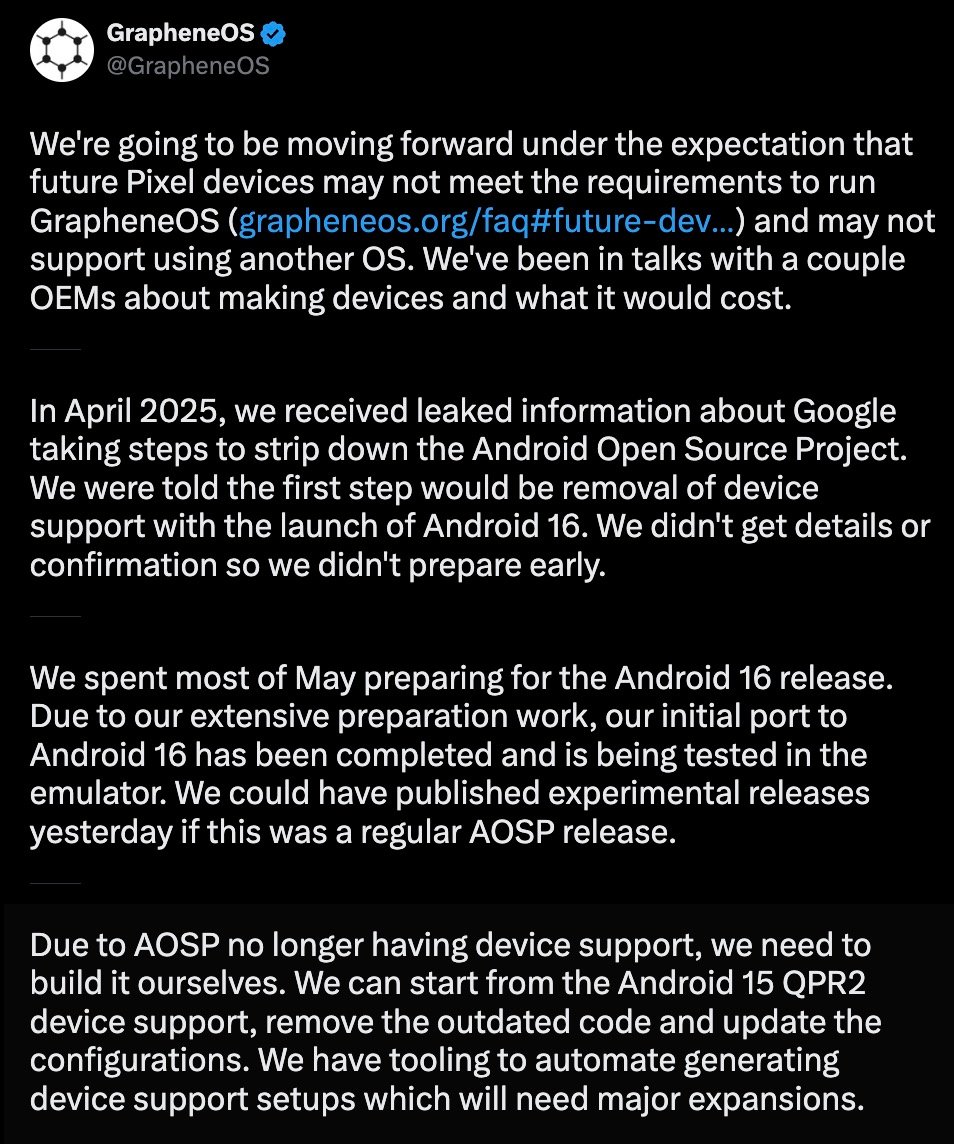If you’re tired of censorship and dystopian threats against civil liberties, subscribe to Reclaim The Net.
Google’s latest move to withhold crucial components from the Android 16 source release has sent ripples through the privacy and custom ROM communities, reviving fears that the Android Open Source Project (AOSP) is being quietly hollowed out.
While the company insists AOSP isn’t being discontinued, its actions are telling a different story for developers who rely on Pixel devices as their foundation.
In a detailed thread, the team behind GrapheneOS confirmed that the Pixel line may no longer meet the conditions required for their project, stating, “We’re going to be moving forward under the expectation that future Pixel devices may not meet the requirements to run GrapheneOS…and may not support using another OS.”
The project has already begun evaluating alternatives, including talks with other hardware vendors about what it would take to build custom devices.

The warning signs came earlier this year. “In April 2025, we received leaked information about Google taking steps to strip down the Android Open Source Project,” GrapheneOS explained.
They were told that device support would be dropped alongside Android 16. Although they didn’t receive full confirmation at the time, preparations began in earnest, especially as May approached.
Despite Google’s claims that AOSP is not going away, the release of Android 16 tells a more complicated story. The expected open-source drop was missing key elements: Pixel device trees, driver binaries, and a complete kernel history.
More: An introduction to GrapheneOS
These omissions make it drastically more difficult to develop custom Android builds for Pixel hardware. GrapheneOS had to delay its Android 16 release because of this.
“Since our port to Android 16 is going to be delayed by a week or more, we’re in the process of backporting the Android 16 firmware/drivers released on June 10 to the previous releases,” they said, noting that their usual rapid development was hindered by the lack of device support.
“We need to build it ourselves,” the GrapheneOS team wrote, pointing out that “AOSP no longer having device support” means starting from the bare minimum and reconstructing everything independently.
More: How to install GrapheneOS on a Pixel smartphone
Google’s public messaging has emphasized Cuttlefish, a virtual Android device, as the new AOSP reference target.
According to Seang Chau, Android’s VP, this shift reflects a broader goal: “AOSP needs a reference target that is flexible, configurable, and affordable — independent of any particular hardware, including those from Google.” But for developers like those at GrapheneOS, this theoretical openness is little consolation in the absence of actual hardware support.
Meanwhile, speculation is mounting about Google’s motivations. GrapheneOS pointed to antitrust pressures and the possibility of a corporate split, citing recent statements and legal actions. “The leaked information we received in April 2025 indicates that the reasoning they’re making substantial cuts to Android is primarily cutting costs, perhaps in anticipation of it being split from Google,” they wrote.
The platform’s increasing reliance on proprietary Play Integrity APIs and the aggressive control over OEM partnerships suggest a strategic clampdown on third-party ecosystems.
This has practical implications. GrapheneOS stressed that “a successful mobile OS will need near perfect iOS or Android app compatibility,” which demands a robust AOSP foundation. Without Google’s cooperation, maintaining this becomes both costly and labor-intensive. They noted that “providing 7 years of proper support like Pixels would be very expensive,” and that releasing a new device every year “as the overlapping costs for all of it would be ridiculous.”
As they evaluate custom hardware options, likely based on a future Qualcomm Snapdragon SoC with memory tagging, GrapheneOS remains clear-eyed about the cost: “The baseline will be several million dollars,” not including the additional funds required for long-term support. Still, the project appears committed to ensuring its survival through new partnerships and potentially even crowdfunding.
For now, the Android landscape is shifting in ways that prioritize Google’s control at the expense of openness.
More: Break Free from Big Tech with These Privacy-First Tablets
Projects like GrapheneOS, built on security, autonomy, and transparency, are being forced to adapt. Whether AOSP survives in name or in practice remains an open question.
The implications of Google’s retreat from supporting its own hardware within AOSP are far-reaching, especially for privacy-focused operating systems like GrapheneOS.
For years, the Pixel line stood as a rare exception in the Android world: a consumer-ready device that was fully unlockable, well-documented, and supported with timely kernel source drops, driver binaries, and complete device trees.
That support structure has now been stripped away, forcing projects that rely on transparency and control to chart a new course.
GrapheneOS, in particular, is facing a turning point. The project’s identity has long been tied to the Pixel platform, not because of brand loyalty, but because of the hardware’s unique openness.
With that foundation eroding, the team now faces a difficult but increasingly necessary choice: either continue reverse-engineering hardware configurations every month just to stay compatible or break away entirely and build an ecosystem on their own terms.
That could mean supporting devices from OEMs that are willing to collaborate more openly or, more radically, spearheading the development of their own hardware.
Such a move would allow them to regain control but at a steep cost in both time and resources.
For users, the consequences are also significant.
Many people turn to de-Googled Android distributions not just for privacy, but for assurance that their devices operate independently of invasive analytics, forced updates, and opaque controls.
If Pixel devices lose their status as a viable base for these efforts, the remaining landscape of Android hardware offers few good alternatives. Most devices come with locked bootloaders, proprietary firmware, and minimal upstream cooperation from vendors.
The erosion of open-source support also threatens to accelerate Android’s shift from a developer-friendly platform to a walled garden shaped entirely by Google. Without access to the full kernel history, it becomes harder to trace changes, identify bugs, and apply timely security patches, essential tasks for any serious OS project.
If you’re tired of censorship and dystopian threats against civil liberties, subscribe to Reclaim The Net.
The post Android Open Source Is Becoming a Controlled Experiment appeared first on Reclaim The Net.
Click this link for the original source of this article.
Author: Rick Findlay
This content is courtesy of, and owned and copyrighted by, https://reclaimthenet.org and its author. This content is made available by use of the public RSS feed offered by the host site and is used for educational purposes only. If you are the author or represent the host site and would like this content removed now and in the future, please contact USSANews.com using the email address in the Contact page found in the website menu.





